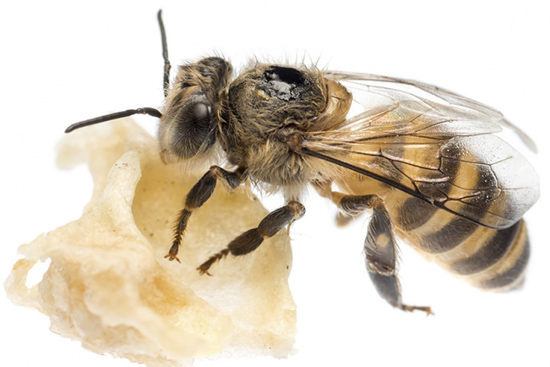Buzz into Summer with New Honeybee Exhibition
Up-close glimpse of pollinators in action at Harvard Museum of Natural History

Visit the new observation hive at the Harvard Museum of Natural History to see honeybees collect pollen and make honey. Photo courtesy of the Harvard Museum of Natural History
With the weather warming up, what better way to escape the heat than checking out a buzz-worthy new exhibition at the Harvard Museum of Natural History?
The show, titled Honeybees in Action, offers visitors a chance to observe an active honeybee hive and get a close-up view of a bee colony at work. Peer into the hive, which is in the museum’s existing Arthropods: Creatures That Rule exhibition, and watch—without getting stung, of course—as these amazing creatures collect pollen, make honey, and guard their eggs and larvae.
Presented in collaboration with the Harvard Undergraduate Beekeepers, the exhibition comes at a critical moment, as the world’s bee population faces collapse or decline from disease, parasites, pesticides, and other factors. Honeybees pollinate at least a third of the crops we consume, and according to the US Department of Agriculture, the number of managed honey bee colonies in this country has decreased from 5 million in the 1940s to 2.5 million today, while the call for hives to provide pollination services has increased. The museum’s observation hive allows visitors to appreciate the often unnoticed intricacies of these great pollinators.
After viewing those busy bees, check out the museum’s many other exhibitions. First-timers should be sure to catch the famous collection of glass flowers, a fitting companion piece to the honeybees. Father and son Leopold and Rudolf Blaschka, expert 19th-century glass artisans, spent five decades crafting beautiful and intricate life-size models of 847 different species of plants. The museum has 3,000 models on display, some on view for the first time in more than a decade, including some striking models of bees pollinating flowers.
The Honeybees in Action exhibition is on view at the Harvard Museum of Natural History (HMNH), 26 Oxford St., Cambridge, through October 24. The museum is open daily from 9 a.m. to 5 p.m. Admission includes access to all exhibitions and is free for members, for Massachusetts residents Sunday mornings from 9 a.m. to noon with proof of residency, and for children under three; $12 for adults; $10 for seniors and non-Harvard students with ID; and $8 for children ages 3 to 18. Adjacent to HMNH is Harvard’s Peabody Museum of Archaeology & Ethnology, one of the oldest museums of its kind in the world, featuring items from Native American totem poles to treasures of the ancient world. Admission to one museum admits you to both during regular hours. Take a MBTA Red Line train to the Harvard Square stop, and walk through Harvard Yard. Parking by the museum is limited, so public transportation is suggested.
Mara Sassoon can be reached at msassoon@bu.edu.

Comments & Discussion
Boston University moderates comments to facilitate an informed, substantive, civil conversation. Abusive, profane, self-promotional, misleading, incoherent or off-topic comments will be rejected. Moderators are staffed during regular business hours (EST) and can only accept comments written in English. Statistics or facts must include a citation or a link to the citation.